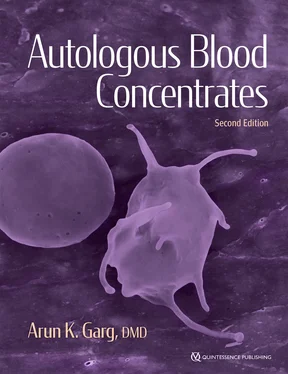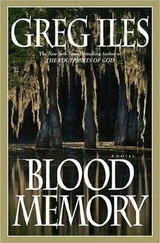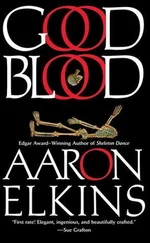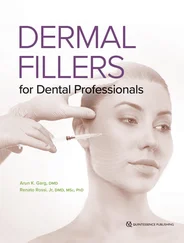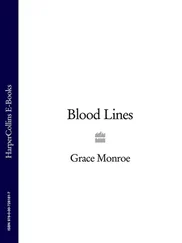Autologous Blood Concentrates, Second Edition
Library of Congress Cataloging-in-Publication Data
Names: Garg, Arun K., 1960- author.
Title: Autologous blood concentrates / Arun K. Garg.
Description: Second edition. | Batavia, IL : Quintessence Publishing Co, Inc, [2021] | Includes bibliographical references and index. | Summary: “Presents the science and biology of PRP and other autologous blood concentrates before demonstrating its use in implant surgery, soft and hard tissue healing, facial cosmetics, and other clinical applications”-- Provided by publisher.
Identifiers: LCCN 2021005706 (print) | LCCN 2021005707 (ebook) | ISBN 9781647240837 (hardcover) | ISBN 9781647240844 (epub)
Subjects: MESH: Platelet-Rich Plasma | Blood Platelets--physiology | Blood Transfusion, Autologous | Plasma--physiology | Bone Regeneration--physiology | Oral Surgical Procedures
Classification: LCC QP97 (print) | LCC QP97 (ebook) | NLM WH 400 | DDC 612.1/17--dc23
LC record available at https://lccn.loc.gov/2021005706
LC ebook record available at https://lccn.loc.gov/2021005707
A CIP record for this book is available from the British Library.
ISBN: 9781867150837

©2022 Quintessence Publishing Co, Inc
Quintessence Publishing Co, Inc
411 N Raddant Road
Batavia, IL 60510
www.quintpub.com
5 4 3 2 1
All rights reserved. This book or any part thereof may not be reproduced, stored in a retrieval system, or transmitted in any form or by any means, electronic, mechanical, photocopying, or otherwise, without prior written permission of the publisher.
Editor: Leah Huffman
Design: Sue Zubek
Production: Angelina Schmelter
Printed in Croatia
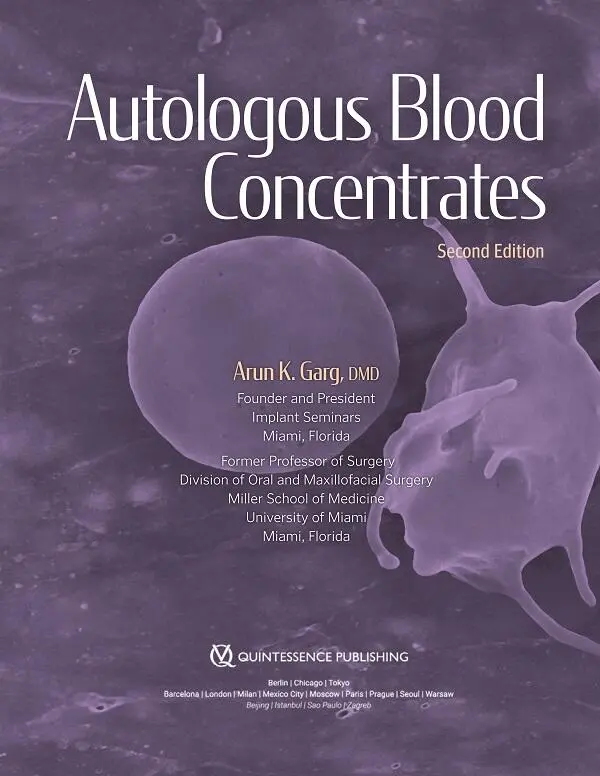
Preface
1 Autologous Blood Concentrates: The Science of Natural Wound Healing
2 Medical and Surgical Applications of Autologous Blood Concentrates
3 Biologic Growth Factors, PRP, and Bone Morphogens in Bone Regeneration Procedures
4 Eight Forms of Autologous Blood Concentrate: Preparation and Clinical Applications
5 Dental Implants, Osseointegration, and Autologous Blood Concentrates
6 Oral Cavity Soft Tissue Healing and Autologous Blood Concentrates
7 Oral Cavity Hard Tissue Healing and Autologous Blood Concentrates
8 Facial Cosmetics and Autologous Blood Concentrates
9 The Future of Autologous Blood Concentrates
10 Principles and Practice of Phlebotomy
Index
In the nearly 25 years since Bob Marx and I developed the original formula for PRP, I have followed its gradual evolution from controversial idea to vital wound healing agent with keen interest—not unlike an anxious parent. In 2005, our co-authored book— Dental and Craniofacial Applications of PRP (Quintessence)—introduced the concept of platelet-rich plasma (PRP) to the world and provided scientific and clinical proof of its efficacy. Together, we spent the next decade training other clinicians on the proper use of PRP.
Everything changed in 2010, when it became public knowledge that PRP was the secret to Tiger Woods’s speedy recovery from a torn ACL. Commercial interests quickly co-opted the conversation, drowning out the voices of those who, like Marx and me, did not want to see this low-cost biotechnology exploited by profit-hungry manufacturers of centrifuge devices. There was also an enormous amount of misinformation being promulgated by certain medical/dental experts who recognized the enormous therapeutic potential of autologous growth factors and seized the opportunity to establish a name for themselves in the scientific community. The medical literature became saturated with articles introducing new terminology to describe slightly modified growth factor compositions, often without much (if any) additional clinical benefit. The result was an alarming lack of standardization in protocols, a nomenclature best described as an alphabet soup of acronyms, and an overwhelming sense of confusion among clinicians. In 2015, when I published the first edition of this book, my primary motivation was to “set the record straight.”
So the first edition of this book was my effort to refocus the conversation about platelet-derived therapies in order to make PRP accessible again to the practicing clinician. In titling the book, I made the major concession of using a generic term—autologous blood concentrates—as a way to signal my desire to focus on the science and not the politics. I wanted the book to reach clinicians regardless of which machine or nomenclature they were most familiar with.
In the world of regenerative biotechnology, 6 years is a very long time, and much has happened since the first edition of this book was published. This new second edition has been thoroughly revised, updated, and expanded to reflect current understanding, applications, and protocols of PRP for clinicians who have been using or wish to start using PRP in their practice. The centerpiece of this edition is a completely new chapter that details the step-by-step formulas and processes for preparing eight configurations of PRP and the specific indications for using each one. How and when to apply the various configurations in clinical dentistry—for soft tissue preservation, hard tissue preservation and regeneration, and facial rejuvenation procedures—is the subject of subsequent chapters. Because the use of PRP requires the clinician or an assistant to perform a venipuncture, the final chapter is a comprehensive guide to the principles and practice of phlebotomy.
I continue to engage in clinical PRP research, both in my private practices and through my charitable foundation, and will remain a passionate advocate for its use for the benefit of patients everywhere.
1 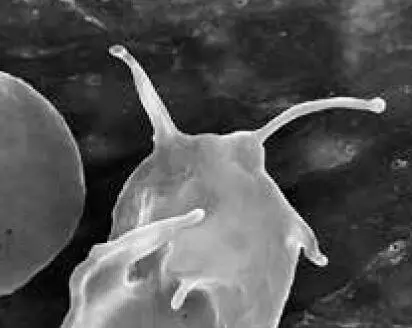
Autologous Blood Concentrates: The Science of Natural Wound Healing
In many ways, traditional surgery and the medical arts have always tried to remove barriers to natural wound healing. Removal of these barriers proved that through replicable conditions and cases, standardized protocols could be created and followed to enhance wound healing. Over time, replication of results led to even more standardized techniques and procedures. For example, wound debridement and administering antibiotics demonstrably helped prevent infection, and stabilizing wounds and placing tissues in closer physical proximity promoted healing. These particular kinds of standardized, replicable surgical techniques can be labeled assistive or nonobstructive. 1However, beginning in the last quarter of the 20th century, a truly “proactive” phase in surgical medicine began with the discovery that macrophages, reacting with oxygen, release growth factors that promote wound healing. 2–6An assortment of cellular/tissue and oxygen-related therapies followed, 7–16culminating only about two decades ago in the use of growth factors produced from concentrated autologous blood platelets to promote wound healing. 17–22The result is medical science’s present focus on platelet and other biologic/regenerative therapies as critical means for promoting, initiating, and sustaining wound healing. 23
Читать дальше
